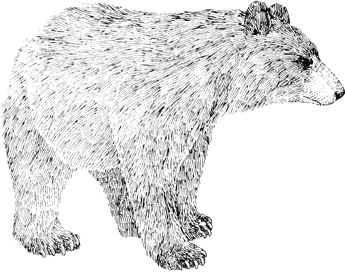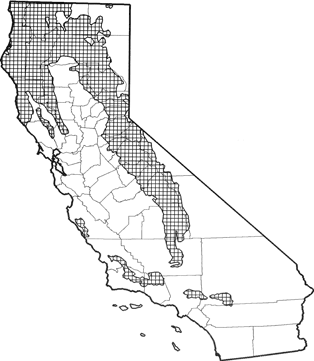
Black Bear
Distribution, Abundance, and Seasonality
Widespread, common to uncommon resident occurring from sea level to high mountain regions. Found in the North Coast Ranges, Cascades, Sierra Nevada, parts of the South Coast Ranges, and in the San Gabriel and San Bernardino Mts. Occurs in fairly dense, mature stands of many forest habitats, and feeds in a variety of habitats including brushy stands of forest, valley foothill riparian, and wet meadow.

Range Map
Specific Habitat Requirements
Feeding: Black bears are omnivorous. They feed largely on grasses and forbs, fruits, nuts, insects, and carrion. Also consume human refuse. Black bears are seasonal specialists, feeding on grasses and forbs in early spring, insects and fruits (e.g., manzanita berries) in summer, and on acorns and other nuts and fruits in fall. They forage on the ground, and as high as they can reach in shrubs and trees. Black bears fish, dig, and climb trees for food; they also graze, and pull branches of trees and shrubs to their mouth with forelimbs.
Cover: Require large trees and various cavities and hollows in trees, snags, stumps, logs, uprooted trees, talus slopes, or in the earth for denning. These habitat elements must be in mature, dense vegetation, and on sheltered slopes for adequate denning.
Reproduction: Young born in winter dens in hollow bases of trees, snags or stumps, in hollow logs, rock caves, or in holes dug in ground. Usually in dense, mature vegetation on sheltered slopes.
Water: Black bears probably need drinking water when not in winter dormancy, or feeding heavily upon succulent forage.
Pattern: Mature vegetation provides escape cover and specific habitat elements for denning, breeding, and feeding. Riparian, deciduous, and lower seral stages provide grasses, forbs, and fruits.
Species Life History
Activity Patterns: Mostly nocturnal and crepuscular; some daytime activity. Usually dormant in winter, although may be brief periods of activity.
Seasonal Movements / Migration: Commonly move seasonally to different habitats, including some altitudinal migration.
Home Range: In northwestern California in summer, home ranges of adult males averaged 10.6 km? (4.1 mi?), and varied from 2.6 to 19.7 km? (1.0 to 7.6 mi?). Those of adult females averaged 3.6 km? (1.4 mi?), and varied from 1.8 to 4.4 km? (0.7 to 1.7 mi?) (Kelleyhouse 1975). In the San Bernardino Mts., home ranges of males varied from 7.4 to 53.6 km? (2.8 to 20.6 mi?), and averaged 22.4 km (8.6 mi?) (Novick 1979). In western Washington, home ranges of adult and yearling males averaged 51.5 km2 (19.9 mi2); those of adult and yearling females averaged 5.3 km? (2.0 mi?), and varied from 3.4 to 87 km? (1.3 to 33.6 mi?) (Poelker and Hartwell 1973).
Territory: Females may be territorial in some areas (Piekielek and Burton 1975).
Reproduction: Mid-June to mid-July is peak estrus. Ovulation induced by copulation; implantation of blastocyst delayed approximately 4 mo. Gestation period about 220 days. Most young born from late January to early February while female is denned. One to 6 young born (average = 1.6 to 2.6). Young nurse for at least 6 mo and stay with female for 1.5 yr, but can survive on own at 7 mo. Females mostly breed in alternate yr, some as early as 3rd yr. By 4th summer, 44% of females breed, and all by 5th summer. Thus, has one of lowest reproductive rates of any wild land mammal in North America. Individuals can live 25 yr, or more.
Niche: Black bears are the largest terrestrial species in the Order Carnivora in California. Adults have few predators other than humans. Trichinosis is common in bears. In years of poor mast production, compete with other mast-eaters such as wild pigs, mule deer, and squirrels. Can be pests, particularly at campsites, when they feed on human refuse and occasionally take stored foods. Sometimes damage and kill trees by scraping bark and feeding on cambium; occasionally damage orchards and beehives.
Sources & References
California Department of Fish and Game, 1999.
California's Wildlife, Sacramento, CA.
Written by: G. Ahlborn, reviewed by: M. White, edited by: M. White, G. Ahlborn
Boyer, K. B. 1976. Food habits of black bears (Ursus americanus) in the Banning Canyon area of San Bernardino National Forest. M.S. Thesis, Calif. State Poly. Univ., Pomona. 63pp. Bray, O. E., and V. G. Barnes, Jr. 1967. A literature review on black bear populations and activities. Colorado State Univ. Coop. Wildl. Res. Unit, Fort Collins. 34pp. Herrero, S. 1972. Aspects of evolution and adaptation in American black bears (Ursus americanus Pallas) and brown and grizzly bears ( U. arctos Linne) of North America. Pages 221-231 in S. Herrero, ed. Bears-their biology and management. IUCN Publ., New Series No. 23. Morges, Switzerland. 371pp. Jonkel, C. J., and I. McT. Cowan. 1971. The black bear in the spruce-fir forest. Wildl. Monogr. No. 27. 57pp. Kelleyhouse, D. G. 1975. Habitat utilization and ecology of the black bear in northern California. M.S. Thesis, Humboldt State Univ., Arcata. 60pp. Moss, H. H. 1972. A study of the black bear in the San Gabriel Mountains. M.S. Thesis, Calif. State Poly. Univ., Pomona. 63pp. Novick, H. J. 1979. Home range and habitat preferences of black bears (Ursus americanus) in the San Bernardino Mountains of southern California. M.S. Thesis., Calif. State Poly. Univ., Ponoma. 58pp. Piekielek, W. P., and T. S. Burton. 1975. A black bear study in northern California. Calif. Fish and Game 61:4-25. Poelker, R. J., and H. D. Hartwell. 1973. Black bear in Washington. Wash. State Game Dep., Biol. Bull. No. 14. 180pp. Walraven, M. E. 1978. A simulation model for management of black bear problems in Sequoia National Park. Cal-Neva Wildl. 1978:52-64.
California Animal Facts | California's Wildlife